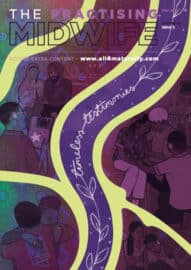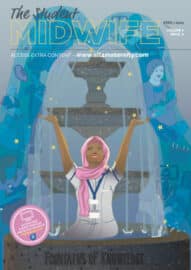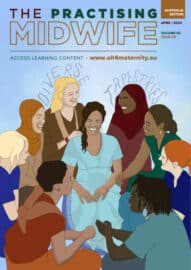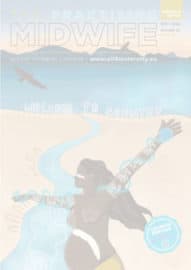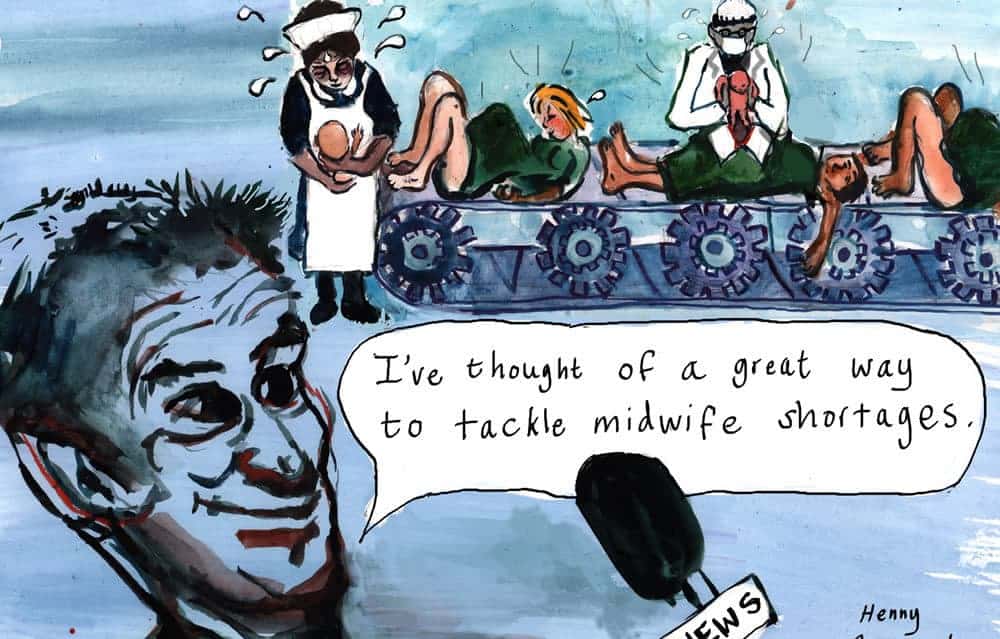By Laura Godfrey-Issacs
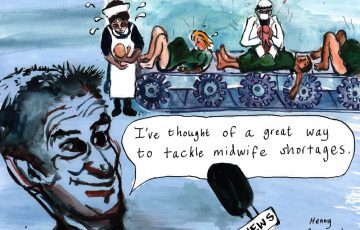
Henny Beaumont (2017) ‘I’ve thought of a great way to tackle midwife shortages’
Recent political events in the UK and globally are a gift for satirists, such as Henny Beaumont – artist, writer and disability activist – and subsequently we see a resurgence of political sketches and lampooning in the media. But, are the current debates raging in the birth world over language, the future of the NHS, staffing and ideology, appropriate territory for cartoonists, and can they cut through the increasingly polarised debate and bring humour, clarity and fresh perspectives in accessible and direct ways?
When I saw a powerful image on social media by Henny about internet trolling of women in the 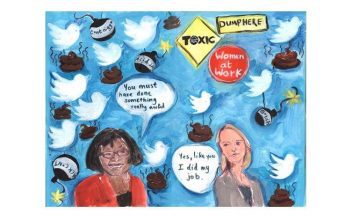 media (principally Laura Kunsberg, political editor at the BBC – see left) – I asked her to create one on current midwifery issues. What she has produced (above), in an exclusive for this Birth, Art & Culture Blog , presents a searing political satire about the consequences of midwife shortages in England– estimated by the RCM (2017) to be 3,500.
media (principally Laura Kunsberg, political editor at the BBC – see left) – I asked her to create one on current midwifery issues. What she has produced (above), in an exclusive for this Birth, Art & Culture Blog , presents a searing political satire about the consequences of midwife shortages in England– estimated by the RCM (2017) to be 3,500.
So, after countless twitter battles including those over inflammatory tweets by Jeremy Hunt, Secretary of State for Health, around the RCM’s change in language on ‘normal birth’ and a connection with stillbirth rates, in August 2017, perhaps satire, humour and incisive images can cut through. Perhaps too cartoons can illuminate some of the real issues – such as the interminable pressure on midwives (and all birth workers), and the knock on effects this has on care and safety for women, babies and families.
Cartooning presents other opportunities, and by accessing the brilliant work, particularly by many women artists around birth, we can reveal a rich territory of previously unrepresented perspectives and voices such as LGBTQI experiences of pregnancy, birth and parenting. Cartoons can also be used to enhance birth education and information, and address cultural stereotypes around birth and mothering, particularly in the mainstream media, and give room to many under-represented and marginalised voices.
Historical satire and depictions of midwives and birth
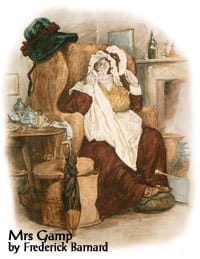
Historically, midwives do not fare well in cartoons and satire – we might think back to the drunken, disreputable and grotesque figure of Sarah Gamp in Charles Dickens novel Martin Chuzzlewit, published in monthly instalments (with illustrations) between 1842 – 1844 – pictured here in Frederick Barnard’s illustration.
Frederick Barnard (1842) Sarah Gamp from the novel Martin Chuzzlewit by Charles Dickens
Unfortunately, many contemporary media accounts of midwives, seem to depict similarly abhorrent behaviour in caricature – such as this headline in the Daily Mail (Glanfield, 2014) ‘Hurry up and have your baby or I will cut you; What midwife allegedly told expectant mother ‘because she wanted to go home and have a takeaway curry’. This is alongside the damaging revelations about a team of midwife ‘musketeers’ pursuing normal birth ‘at any cost’ exposed, and much vilified since, in the Morecambe Bay scandal (Kirkup, 2015) – the source of much of the controversy around the idea of midwives’ ‘promotion’ of ‘normal birth’.
Shifting perspectives
In contrast, some examples of how cartoons can illuminate and extend our understanding and flesh out experiences of maternity include Henny’s insightful personal account of giving birth to and bringing up her daughter, Beth, who has Down’s Syndrome, in the graphic novel ‘Hole in the Heart’ (Beaumont, 2016) (see images below).
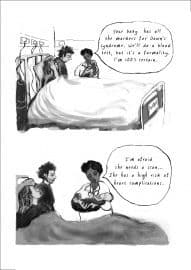
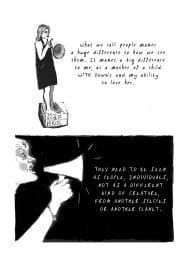
Henny Beaumont (2016) Hole in the Heart – Bringing up Beth. Myriad Editions, UK http://www.hennybeaumont.com
This work brings powerful drawings and text together to create valuable insights for midwives and birth workers, as well as other parents and provides a voice to children with Down’s syndrome and disability activists. Even though health care professionals’ behaviour is not always represented well in this account, there is much room for learning – including around the contentious issue of antenatal testing and terminations for abnormalities, as well as the importance of language (again) and, sensitive care when supporting parents in this situation. This work is hard hitting and important – as well as beautifully rendered.
Challenging taboos
Kate Evans (cartoonist, artist, activist, author, mother) produces hilarious and highly informative books such as ‘Bump: how to make, grow and birth a baby’ (2014) and ‘The Food of Love: your formula for successful breastfeeding’ (2008) which are great alternatives to many more worthy or authoritarian pregnancy and birth manuals – and include diverse perspectives such as the consideration of childlessness. She also addresses many everyday challenges and situations pregnant women face – from people touching your belly without permission to hormonal challenges – providing a mirror to experience, and permission to laugh, cry and rage with reassurance that it’s all OK!
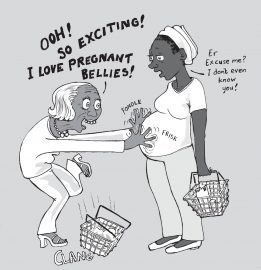

Kate Evans (2014) Bump: how to make, grow and birth a baby. Myriad Editions, UK http://www.cartoonkate.co.uk
Furthermore, A.K Summer’s brilliant account of her pregnancy and birth: ‘Pregnant Butch’ (2014) unpacks the seldom considered experiences for lesbian mothers, particularly those who identify as butch, and the challenges to gender stereotypes this brings, all the more urgently when going through one of the most tightly constrained and seemingly ‘feminine’ of experiences.
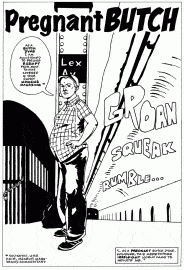
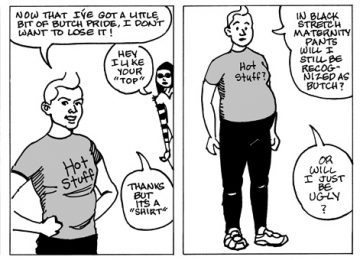
Copyright © 2014 by A.K. Summers from Pregnant Butch. Used by permission of Soft Skull, an imprint of Counterpoint.
Another interesting artist is Lucy Knisley who takes a wiry look at expectations around pregnancy and birth and the public scrutiny of women’s bodies, during pregnancy and childbirth – you can access her work here: http://www.lucyknisley.com
Cartoons in action
Increasingly we see cartoons in public health and campaign videos by organisations such as the White Ribbon Alliance (2017) – used as an effective tool to communicate with a diverse range of people, by condensing complex issues into images with minimal text, and it’s a strategy employed on the website here at all4maternity – creating a friendly, welcoming and informal platform for information giving.
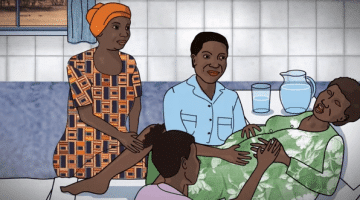
White Ribbon Alliance (2017) Respectful Maternity Care –http://whiteribbonalliance.org/videos/
Equally, infographics – which use a form of cartooning, are being used more and more in maternity information contexts to communicate subjects such as birth positions, visual birth plans, delayed cord clamping and more.. see Hannah Tizard’s excellent blog section ‘Maternity Media Hotspot’ on this website for more information. These can be useful as aids for women who may have limited literacy or English as a second language. Apps, such as the Baby Buddy App by Best Beginnings (below), can particularly help engage younger parents who respond to information being presented in this way, rather than traditional leaflets and public health messaging.
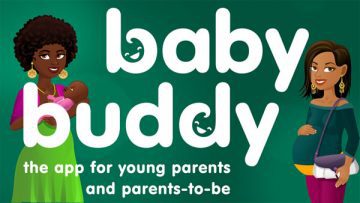
Baby Buddy App from Best Beginnings https://www.bestbeginnings.org.uk/about-baby-buddy
Kate Evans illustrations – Positions in Labour, for the Positive Birth Book by Milli Hill (2017) printed by Pinter & Martin, UK
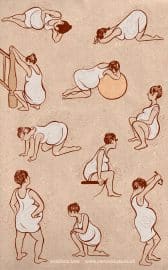
Furthermore, in a recent project, Maternal Journal (2017) – a series of creative workshops around journaling – which I produced with psychiatrist Carmine Pariante, for pregnant women with a history of mental health problems (funded by the King’s Cultural Institute https://www.kcl.ac.uk/Cultural/-/Projects/Arts-in-Mind-Innovation.aspx), we held a very successful cartooning workshop with Kate Evans. Here the act of cartooning proved a popular way for the women to document experiences and feelings about their pregnancy.
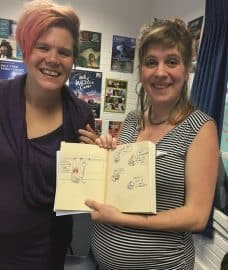
Maternal Journal cartooning workshop with Kate Evans (funded by the King’s Culture Institute https://www.kcl.ac.uk/Cultural/-/Projects/Arts-in-Mind-Innovation.aspx
Therefore, cartoons, in all forms and contexts – whether political satire, infographics, public health messaging or for personal creative outlet, provide exciting opportunities to address and communicate some of the many complex issues in maternity.
Applications to practice
- Recommend alternative pregnancy manuals that use cartoons – such as Kate Evans’ books.
- Use Infographics and apps – such as The Positive Birth Movements birth positions infographic and the Baby Buddy App, which can particularly help when supporting young women or women with variable literacy levels or English as a second language
- Explore social marketing techniques when promoting public health messages that use cartoons, such as The White Ribbon Alliance’s films.
- Use drawing and cartoons in antenatal education to help women articulate feelings and experiences which may otherwise be difficult to express.
Image Credits
Image 1 – Beaumont H (2017) ‘I’ve thought of a great way to tackle midwife shortages’ – commissioned by the Birth, Art & Culture Blog – courtesy of the artist
Image 2 – Beaumont H (2017) Women at Work – Dump here. Canary Magazine – courtesy of the artist
Image 3 – Barnard F (1842) Sarah Gamp from the novel Martin Chuzzlewit by Charles Dickens
Images 4 & 5 – Beaumont H (2016) Hole in the Heart – Bringing up Beth. Myriad Editions, UK http://www.hennybeaumont.com – courtesy of the artist
Images 6 & 7 – Evans K (2014) Bump: how to make, grow and birth a baby. Myriad Editions, UK http://www.cartoonkate.co.uk – courtesy of the artist
Images 8 & 9 – Copyright © 2014 by A.K. Summers from Pregnant Butch. Used by permission of Soft Skull, an imprint of Counterpoint – courtesy of the artist
Image 10 – White Ribbon Alliance (2017) Respectful Maternity Care –http://whiteribbonalliance.org/videos/
Image 11 – Baby Buddy App from Best Beginnings https://www.bestbeginnings.org.uk/about-baby-buddy
Image 12 – Evans K (2017) Positions in Labour, in The Positive Birth Book, Hill M Pinter & Martin, UK – courtesy of the artist
Image 13 – Maternal Journal cartooning workshop with Kate Evans (funded by the King’s Culture Institute https://www.kcl.ac.uk/Cultural/-/Projects/Arts-in-Mind-Innovation.aspx) – courtesy of the artist
References
Beaumont H (2016) Hole in the Heart – Bringing up Beth. Myriad Editions, UK http://www.hennybeaumont.com
Glanfield E (2014) ‘Hurry up and have your baby or I will cut you’ Daily Mail. Available online at: http://www.dailymail.co.uk/news/article-2632785/Hurry-baby-Ill-cut-What-midwife-allegedly-told-expectant-mother-wanted-home-takeaway-curry.html Accessed on: 29.10.17
Evans K (2014) Bump: how to make, grow and birth a baby. Myriad Editions, UK
Evans K (2008) The Food of Love: your formula for successful breastfeeding. Myriad Editions, UK
Kirkup B (2015) The Report of the Morcombe Bay Investigation. Available online at: https://www.gov.uk/government/uploads/system/uploads/attachment_data/file/408480/47487_MBI_Accessible_v0.1.pdf Accessed on: 29.10.17
Maternal Journal (2017) available online at: https://www.facebook.com/maternaljournal/ Accessed on: 30.10.17
RCM (2017) RCM Comments on Jeremy Hunt Speech. Available online at: https://www.rcm.org.uk/news-views-and-analysis/news/rcm-comments-on-jeremy-hunt-conference-speech. Accessed on 29.10.17
Summers A.K (2014) Pregnant Butch: nine long months spent in drag. Soft Skull Press, USA
White Ribbon Alliance (2017) – Videos. Available online at: http://whiteribbonalliance.org/videos/ Accessed on: 29.10.17

